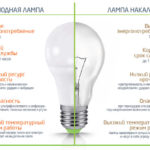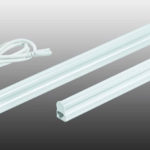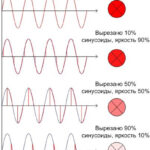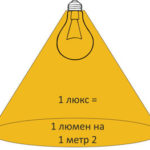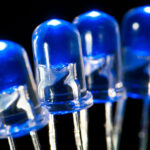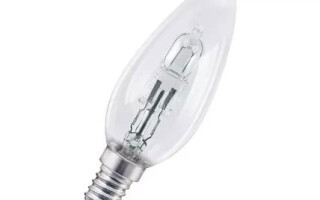With the rise in electricity prices, consumers are switching more and more to economical and energy-saving lighting fixtures. A big role in saving also plays the duration of operation of the lamp before it fails, as well as the quality of its glow. According to these characteristics, halogen lamps are the most popular.
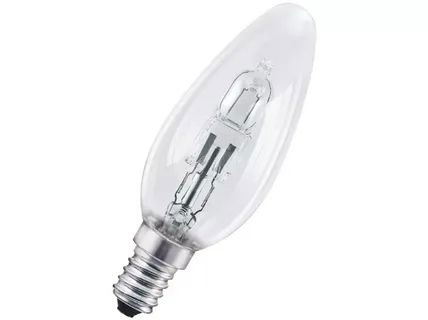
Contents
What is a halogen lamp, structure and principle of operation
Halogen lamp - One of the varieties of standard incandescent lamps. The main distinguishing feature of its construction lies in a special gas - halogen, which is pumped into the bulb of the device.
The principle of operation of such a lighting device (as with standard incandescent lamps) is based on passing an electric current through a filament body and heating that body until it glows. But thanks to halogen vapors (bromine or iodine are most commonly used for this purpose), the temperature of the tungsten coil is considerably increased and the luminous efficiency is increased. This is because the tungsten atoms evaporate when heated and condense on the bulb, but iodine or bromine, react chemically with the tungsten and prevent it from settling. These compounds decay rapidly when heated and the tungsten atoms condense back onto the filament, and this increases the temperature of the filament body.
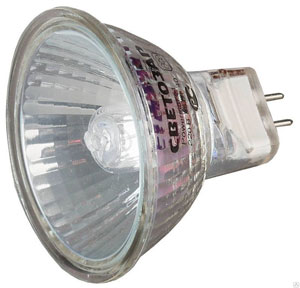
Otherwise, the entire design of the lamp is no different from standard incandescent lamps: a halogen lamp has a bulb, a filament with conductors and a base. The manufacturers of such devices produce lamps with all kinds of standard bases, so the consumer can use such lamps in any lighting fixture.
Where are halogen lamps used?
Halogen lamps are long-lasting and bright lighting devices that are resistant to temperature and voltage fluctuations. The bulbs of halogen lamps are made of heat-resistant and resistant to mechanical damage quartz, thanks to which this lamp withstands large temperature fluctuations and can have different sizes from large to the smallest. That is why they are widely used in lighting fixtures in cars and other vehicles.
Halogen lamps are quite often and widely used in everyday life. They are installed in various systems of suspended or stretch ceilings, as well as used in spot lighting or arrangement of different kinds of illumination, installed in chandeliers and various lamps. Most often used in photo and video shooting using halogen spotlights and other lighting devices based on them.
Main types of halogen lamps
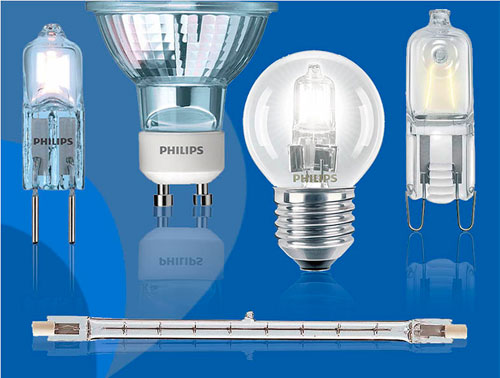
Depending on the appearance and method of application, halogen lamps are divided into several basic types:
- with an outer bulb;
- capsule;
- with a reflector;
- linear.
With outer bulb
With an external or external bulb, a halogen bulb is no different from a standard "Ilich bulb". They can be plugged directly into the 220 volt mains and have any shape and size. The distinctive feature is the presence in the standard glass bulb of a small halogen bulb with a bulb made of heat-resistant quartz. Halogen bulbs with hollow bulb are used in different lamps, chandeliers and other lighting fixtures with E27 or E14 socket.
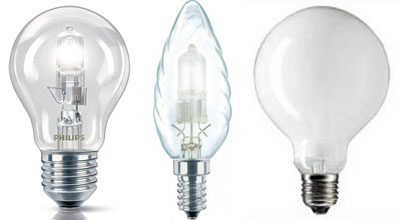
Capsule
Capsule halogen lamps are miniature sized and used for interior illumination. They are low wattage and often used with G4, G5 socket in 12 - 24 volt DC and G9 socket in AC AC 220 volts.
Structurally, such a lamp has a filament body, located in a longitudinal or transverse plane, and on the back of the bulb there is a reflective substance. Such devices due to their low power and size do not require a special protective bulb and can be mounted in luminaires of open type.
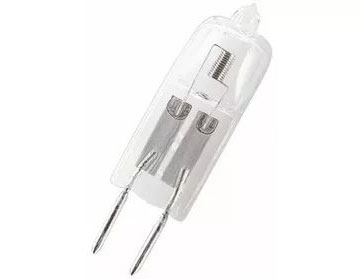
With reflector
Devices with a reflector are designed to emit light in a directional light source. Halogen lamps can have an aluminum or interference reflector. The most common of these two options is aluminum. It redistributes and focuses the heat flux and light radiation forward so that the light flux is directed to the desired point and excess heat is removed, protecting the space and materials around the lamp from overheating.
The interference reflector dissipates the heat inside the lamp. Halogen reflector lamps come in a variety of shape and size configurations as well as different light emission angles.
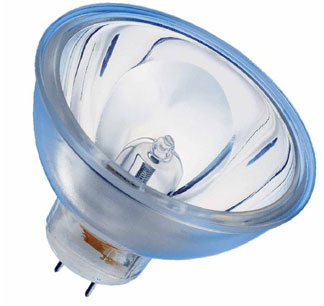
Linear
The oldest type of halogen lamp, which has been in use since the mid-60s of the 20th century. Linear halogen lamps have the appearance of an elongated tube with contacts at the ends. Linear lamps come in a variety of sizes as well as high wattages and are mainly used in various spotlights and street lighting fixtures.
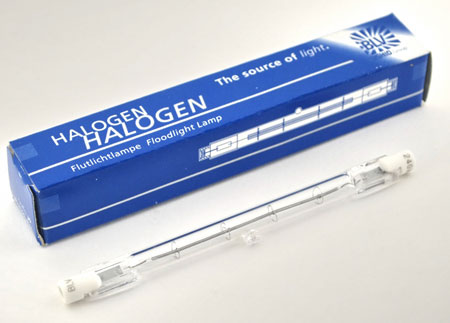
Halogen lamps with IRC coating
IRC halogen lamps are a special type of this kind of lighting fixture. IRC stands for "infrared coating". They have a special coating on the bulb that lets in visible light but prevents infrared radiation. The composition of the coating directs this radiation back to the filament body, thereby increasing the efficiency and effectiveness of the halogen lamp, improving the uniformity of luminescence and light output.
The use of IRC-technology allows you to reduce power consumption of such devices up to 50% and significantly affects the energy efficiency of the lighting. Another advantage is to increase service life by almost 2 times compared to standard halogen lamps.
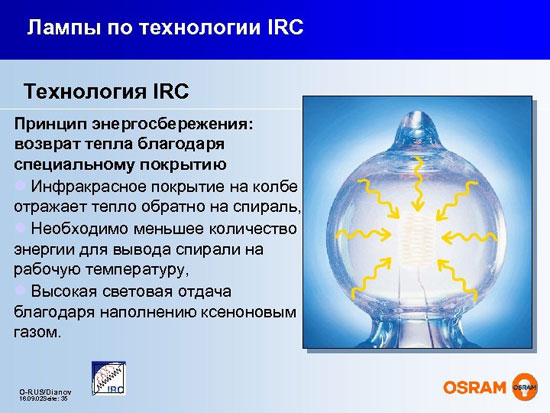
Halogen chandeliers
Halogen chandeliers are one-piece devices that are based on multiple halogen lamps connected in parallel to each other. Such chandeliers have quite different appearance and configuration and due to the small size of halogen lamps they have an aesthetic look and uniform glow.
Halogen chandeliers can be found in stores with 220 volt AC power as well as low-voltage versions for DC applications or use with power supplies.
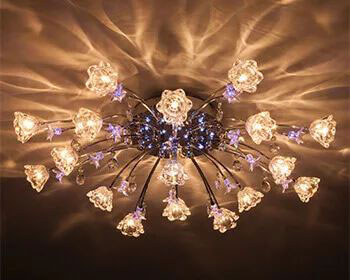
Halogen lamp specifications
In order to choose the right lamp, you need to know what it will be used for, where it will be mounted and under what conditions it will work. Like all other lamps, halogen lamps have the following important characteristics:
Type of base and shape of bulb
Halogen lamps are available with any type of base and shape of the bulb, so there will be no difficulty in choosing a device in this regard. There are options as with the cap E14 and E27, and specific cap G4, G9, R7s.
Voltage
Manufacturers of such lamps produce devices for both AC 220 V and DC 12 - 24 V.
Power
An important characteristic of the lamp, indicating the power consumption of the device. Powerful linear lamps are 100 to 1500 watts, capsule lamps are 10 to 35 watts, and bulbs with an external base or reflector are 20 to 60 watts.
Color temperature
Halogen bulbs usually have an operating color temperature 2500 K to 3000 K.
Lifetime
Halogen lamps are quite durable compared to standard incandescent lamps. They last from 2000 hours and more if the operating conditions are maintained.
Advantages and disadvantages
Like all devices halogen lamps have both advantages and disadvantages.
Advantages
- Service life is the main advantage of these lamps, in comparison with conventional incandescent lamps. Under the right conditions, halogen lamps last 2000 hours or more;
- Stability of luminescence regardless of lamp life;
- Compact size makes it suitable for any application (including in automobile lighting) and organization of any kind of lighting;
- The light output of these lamps reaches 20 Lm/W, which is not a bad value for incandescent lamps;
- Halogen lamps have good color rendering, the light is comfortable for the eyes and does not affect vision.
Disadvantages
- The bulb of a halogen lamp can heat up to a high temperature, which requires special safety measures in operation. For the same reason, these lamps have a rather low efficiency due to the amount of energy they consume in heatingbut higher than that of conventional incandescent lamps.);
- These lamps are sensitive to dirt on the bulb - this quickly puts them out of action. Therefore, in any instruction on the installation and operation of lamps is paid special attention to this;
- Have ultraviolet radiation, so they need to use special bulbs or protective filters.
Comparison with other types of lamps
Halogen lamps are certainly not as energy efficient as LED or fluorescent lamps. fluorescent lamps. In this case, it all depends on the application of the devices. As already mentioned above: halogen lamps are resistant to temperature and voltage fluctuations, which in some conditions clearly puts them above LED lamps.
But comparing them with conventional incandescent lamps, the advantages of these lamps are quite clearly visible. Halogen lamps have a higher efficiency and luminous flux with less power. They are more durable and versatile. The high quality of light transmission is another important argument for choosing halogen lamps.
How to choose a halogen bulb
When choosing halogen lamps, first of all, you should pay attention to the manufacturer of the device: it is better to buy devices from well-known and widespread manufacturers (They are responsible for the quality of products and control it at all stages of production). The most famous companies: Osram, Navigator и Camelion ..
The further choice is no different from that of an ordinary lamp and consists of selecting the required socket type and lamp shapeThe price you are willing to pay for the lamp. The price of the devices depends on the manufacturer, the technical specifications and the size of the halogen lamp.
Related articles:

